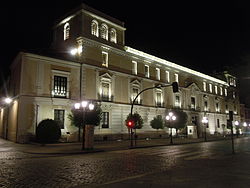Royal Palace of Valladolid
| Royal Palace | |
|---|---|
| Native name Spanish: Palacio Real | |
 | |
| Location | Valladolid, Spain |
| Official name | Palacio Real de Valladolid |
| Type | Non-movable |
| Criteria | Monument |
| Designated | 1999 |
| Reference no. | RI-51-0010470 |
The Royal Palace of Valladolid was the official residence of the Kings of Spain during the period in which the Royal Court had its seat in Valladolid between 1601 and 1606, and a temporary residence of the Spanish Monarchs from Charles I to Isabella II, as well as and also of Napoleon during the War of the Independence. Currently is the headquarters of the 4th General Sub-inspection of the Army.



History
Despite the fact that kings were present in Valladolid often, they lacked an official residence until the 17th century. When the Royal Court moved to the city, the palace of Francisco de Cobos fulfilled that function. Francisco de los Cobos was a State Secretary with Carlos I. Born in Úbeda, De the Cobos forged a spectacular political career. He married in 1522 with María de Mendoza, daughter of the Counts of Ribadavia, achieving thus the nobility rank that he lacked. De los Cobos built his palace nearby his in-laws (Palace of the Counts of Ribadavia) and next to St. Paul's Church, according to a 1524 project of royal architect Luis de Vega. The building was built around a magnificent, Renaissance-styled courtyard. Charles I ordered its extension, resulting in a building of complicated compositions: several courtyards, chapel, state rooms...
Use
Since the 19th century the takes in the General Captaincy of the 7th Military Region (currently the 4th General Sub-inspection) of the Army. At the beginning of the 20th century significant renovations are made, to arrive at the present with numerous structural changes to its original design.

